Chatham and District Light Railway
History
The Chatham and District Light Railway was promoted by the Rochester, Chatham, Gillingham and District Electric Railways Company, and was initially intended to connect all the towns in the company's title. Its draft light railway application — submitted in November 1897 — was significantly revised in light of objections from Rochester Corporation, and amended to add in an additional line, approval being granted on the 17th August 1899. The Light Railway Order also included a change in name, to the Chatham and District Light Railways Company. The C&DLRCo was itself a subsidiary of the British Thomson-Houston Company, which eventually either owned, operated or had a significant shareholding in the following tramways: Cork Electric Tramways, Isle of Thanet Electric Tramways, Lanarkshire Tramways, and Paisley District Tramways.
Although construction of the 3ft 6ins-gauge overhead electric tramway commenced in March the following year, it was to be over two years before the system opened, on the 17th June 1902. The narrow gauge was imposed as a result of the large number of narrow streets and steep hills that the trams would have to traverse. From the Town Hall, lines ran: southwest to Chatham Cemetary via Chatham Station; southeast to Luton and Jezreels Corner via Luton Road and Chatham Hill, respectively; northwards via Dock Rd to Chatham Royal Navy Dockyard, with another line branching off broadly eastward along Brompton Road, High Street and Railway Street to a terminus at Grange Road in Gillingham. This latter line had a branch to the Bathing Pool (Strand) via James Street, Richmond Road and Pier Rd, as well as a connecting line running southeastwards along Canterbury Street to meet the Chatham Hill line at Jezreels Corner.
Passenger loadings were good, the company quickly making plans for major extensions, including an interurban line to Maidstone. Rochester Corporation, however, had its own plans, which clashed with those of the company, and though the two sides initially stuck to their guns, wiser heads eventually prevailed and agreement was reached for Rochester to build the lines within its boundaries, which the C&DLRCo would then operate under a lease. For its part, the company also agreed to build a connecting line from its Chatham Station line along New Road to the Rochester-Chatham municipal boundary. Powers for these lines were acquired in August 1903.
Despite having approval to build approximately 12 miles of extensions, the only lines built by the company — other than minor deviations and doubling of single track — were the connecting line to the Rochester Corporation system and a 3-mile long line from Jezreels Corner along Watling Street, London Road and High Street to a terminus in Rainham. The new lines opened on the 22nd December 1904 and the 25th August 1906, respectively, the former at the same time as the Rochester system. In 1908, the Bathing Pool line was cut back to the Shadlers Arms at the end of Richmond Rd, regular services never having operated to the Strand.
The first of the Rochester Corporation lines opened on the 22nd December 1904, the last on the 17th August 1908. From the Rochester-Chatham boundary in New Road, the main line ran northeastward along High Street, over the River Medway, the line dividing at the Angel Public House, one turning westwards along London Road to a terminus at Stroud Hill, the other turning northeastwards along Frindsbury Road to a terminus opposite Parsonage Lane in Frindsbury. A line also branched off the main line in High Street; this ran along East Row, Maidstone Road and Priestfields to a terminus opposite Manor Lane in Borstal. This brought the C&DLRCo-operated network to its maximum size, just under 15 miles.
New tramcars were ordered for the expanded system, with more being required in 1911 to meet demand. The company's relatively untroubled existence received a severe shock with the outbreak of the Great War in 1914. Not only did it have to suffer the same restrictions on spares and replacement infrastructure (e.g. track) as all other tramways, it was also placed under great strain due to the large numbers of workers travelling to the Royal Naval Dockyard. The tramway also lost men (and their skills) to the armed services, these and the shortage of spares combining to the point where almost one-third of the tramcar fleet was out of service. The situation was somewhat ameliorated in July 1917 by the closure of the neighbouring Sheerness system, from which the C&DLRCo was able to acquire some much-needed materials. Although the company certainly made a profit during these difficult years, the end result was a badly run-down system in need of significant investment. Despite post-war inflation and delays in sourcing replacement parts and new track, the company found the money to put the system back into reasonable order.
Following a short-period of relatively uneventful operation during the early 1920s, when services which had been cut during the war were restored, the spectre of unregulated motorbus competition loomed large on the horizon. The tramway was really in no position to respond effectively to the threat, the narrow streets constraining just how many trams it could run, the competing motorbuses soon extracting significant numbers of passengers. The company's only option was to reduce costs, the services and the infrastructure suffering accordingly. The C&DLRCo's parent company — British Thomson-Houston — clearly saw which way the wind was blowing, selling its subsidiary in 1927 to Maidstone and District Motor Services, itself a subsidiary of the British Electric Traction Company. The new owners invested a little money in sprucing the trams up, though this was to be but a brief hiatus for the tramway, the company obtaining parliamentary approval — in 1929 — to replace the trams with motorbuses, and to change the name of the company to the Chatham and District Traction Company.
A fleet of new motorbuses was ordered, and the necessary infrastructure built to service and support them. Unusually, rather than closing piecemeal, the entire system was closed on one day, the 30th September 1930, motorbuses taking over the following morning.
Uniforms
Photographs of the earliest days of the tramway are rare, but those that have survived show staff wearing single-breasted jackets with lapels, white shirts and drooping-peak caps; it is unclear what badges, if any, these first uniforms carried. They were, however, relatively quickly superseded by single-breasted uniform jackets with five buttons (see link), two breast pockets, stand-up collars, and epaulettes (plain with button closures). The collars bore individual system or company initials — ‘C & D L R’ or 'C & D L R Co', it is unclear which — on the bearer's left-hand side, with the right-hand side left blank, though in later years, script-lettering grade badges — either 'Motorman' or 'Conductor' — were occasionally worn there. The latter appear to have been the standard, 'off-the-shelf' type of grade badges that were used throughout the length and breadth of the land as cap badges. The badges and buttons were brass. The drooping-peak caps were quickly superseded by tensioned-crown (top) peaked caps; these new caps bore a one-piece voided brass cap badge comprising the company's initials, 'C&DLRCo'.
After the Great War, the grade badges were dispensed with, the right-hand jacket collars being left plain again.
Tramcar crews were also issued with double-breasted greatcoats with five pairs of buttons, high fold-over collars and plain epaulettes (with button closures); the collars bore company or system initials — 'C & D L R' or 'C & D L R Co', it is unclear which — in embroidered script-lettering.
Except for a very early shot, and even that taken at a distance, photographs of inspectors appear not to have survived, so other than the fact that they initially wore drooping-peak caps with a pom pom on top, nothing is known.
In common with the vast majority of tramway operators, the C&DLRCo employed female staff during the Great War — as conductresses — to replace male staff lost to the armed services. These ladies do not appear to have been issued with uniforms, instead wearing a variety of informal coats and hats, along with whatever men's caps and greatcoats could be spared. It does, however, seem that a concession was eventually made to sartorial elegance with the issue of baggy motor caps with glossy peaks. These caps carried the same badges as male caps, but were frequently adorned with regimental badges, a common practice across the country during the Great War, to show solidarity for loved ones who were away on military service.
Several photographs also show female staff wearing a shield-shaped badge on either their caps or coats, the purpose of which is unclear.
Further reading
For a history of the Chatham and District Light Railway, see: 'The Tramways of Kent — Volume 1, West Kent' by Invicta; The Light Railway Transport League (1971).
Images
Motormen and conductors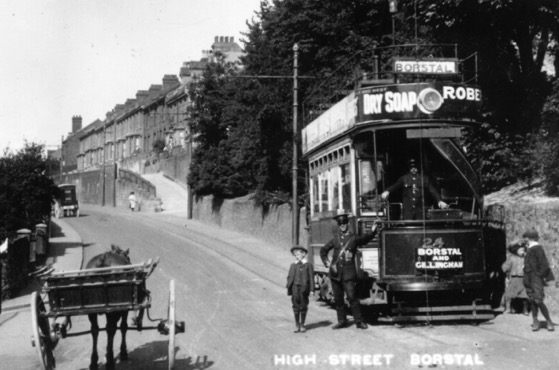
Tramcar No 24 stands with its crew and some decidedly 'un-Borstal-like' children at the Borstal terminus — photo undated, but probably mid-to-late Edwardian. Photo courtesy of the Tramways and Light Railway Society, with thanks to David Voice.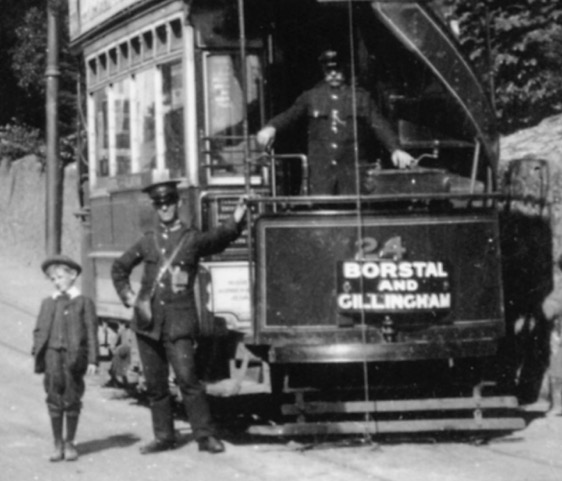
An enlargement of the above photograph showing the conductor and the motorman, both of whom are wearing single-breasted jackets with stand-up collars and tensioned-crown peaked caps.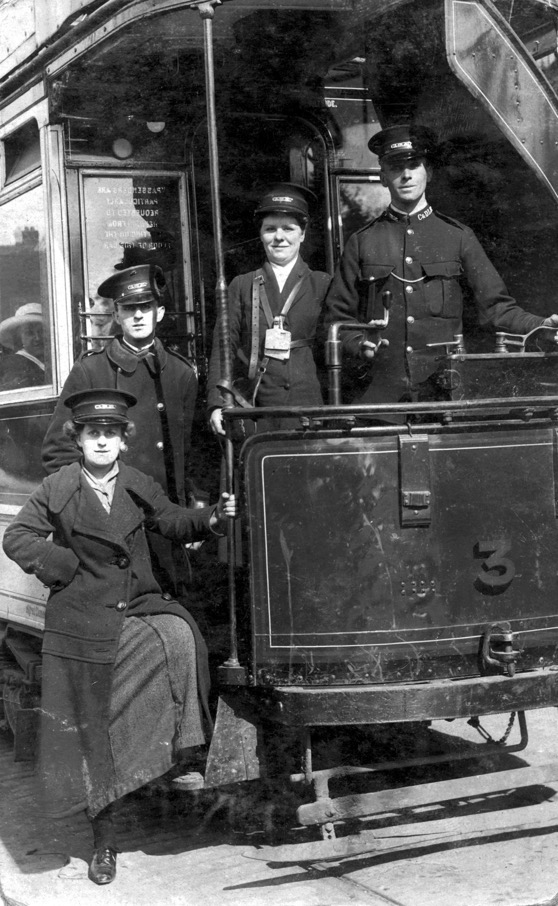
A C&DLR motorman (at the controls) of Tramcar No 3, and a conductress (standing behind the stanchion), along with what is probably another male/female crew — photo undated, but almost certainly taken during the Great War or shortly afterwards. Photo courtesy of the Richard Rosa Collection.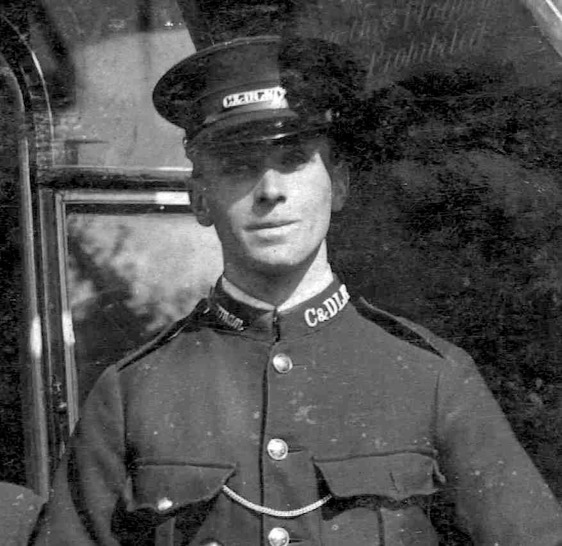
An enlargement of the above photograph showing the motorman. His left-hand collar bears individual system or company initials ('C & D L R' or possibly 'C & D L R Co') whilst his right-hand collar bears a grade badge ('Motorman'). His tensioned-crown peaked cap bears a one-piece voided company-initials badge, 'C&DLRCo'.
C&DLRCo cap badge — brass. John Lodge Collection.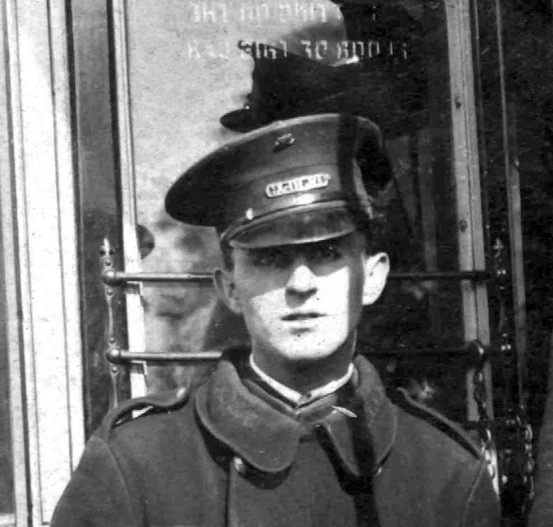
Another blow-up of the above photograph, this time showing the individual in the greatcoat, who is more than likely also a motorman. The greatcoat collars appear to bear embroidered system or company initials — 'C & D L R' or 'C & D L R Co' — whilst his cap bears a small shield-shaped badge that is not seen in other photos, and is in all probability, a regimental or volunteer training corps badge.
Standard ‘off the shelf’ script-lettering grade badges of the type used by the C&DLRCo, though most unusually for a British Isles tramway, as collar rather than cap badges — brass. Author's Collection.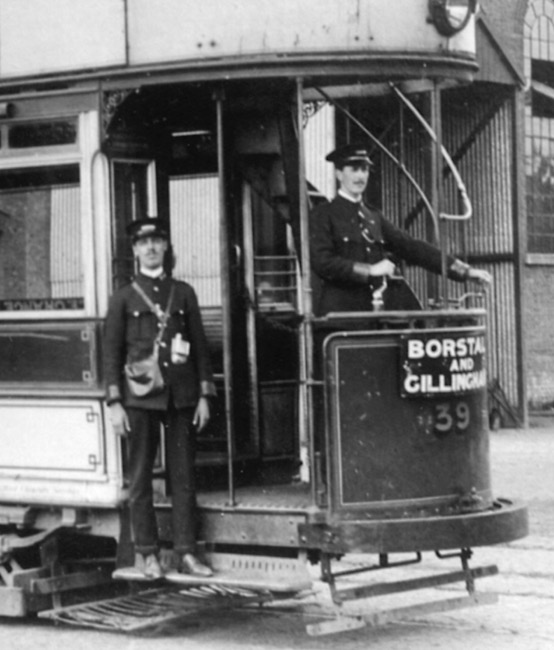
A conductor and a motorman pose with Tramcar No 29 at the depot at Luton — photo undated, but possibly taken during or shortly after the Great War. Neither man appears to be wearing a grade badge on his right-hand collar, suggesting that they had been dispensed with by this time. Photo courtesy of the Tramways and Light Railway Society, with thanks to David Voice.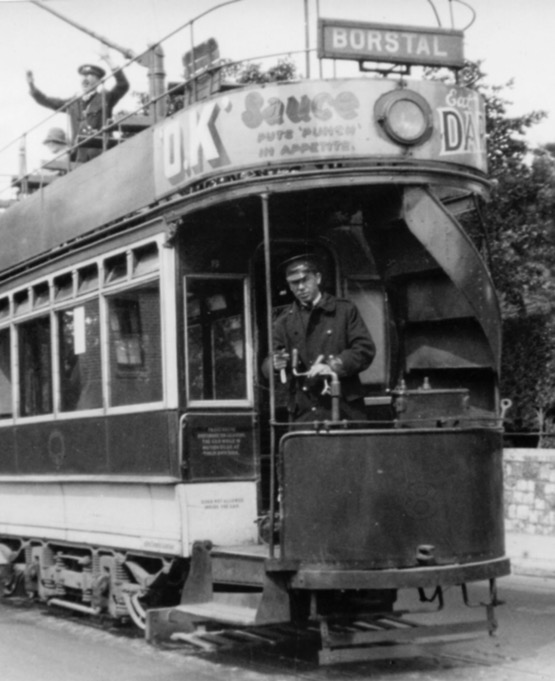
A conductor (turning the trolley pole on the top deck) and a motorman aboard Tramcar No 8 outside the Cemetery terminus — photo undated, but probably taken in the mid-1920s. Photo believed to be by H A Whitcombe, courtesy of the Tramways and Light Railway Society, with thanks to David Voice.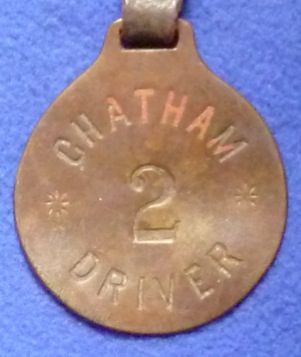
A Chatham licence badge — brass. This is provided for interest, as there is absolutely no evidence to suggest that tramcar crews were ever issued with these. Author's Collection.
Female staff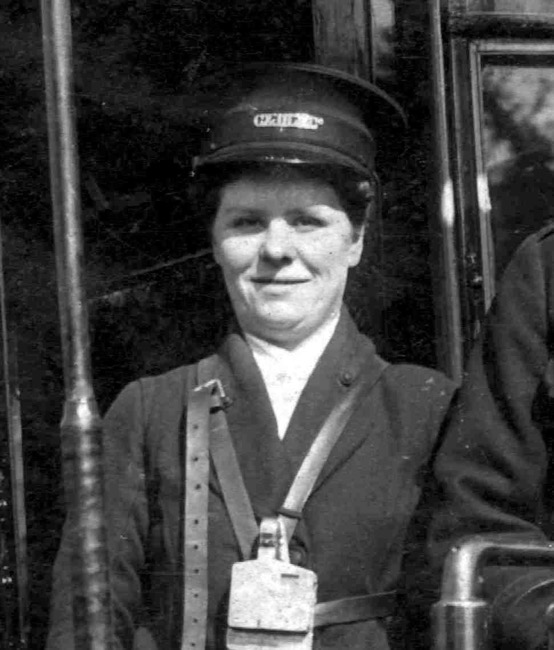
An enlargement of the shot of Tramcar No 3 above showing the conductress. Although she is wearing a company cap and cap badge, the rest of her uniform would appear to be makeshift.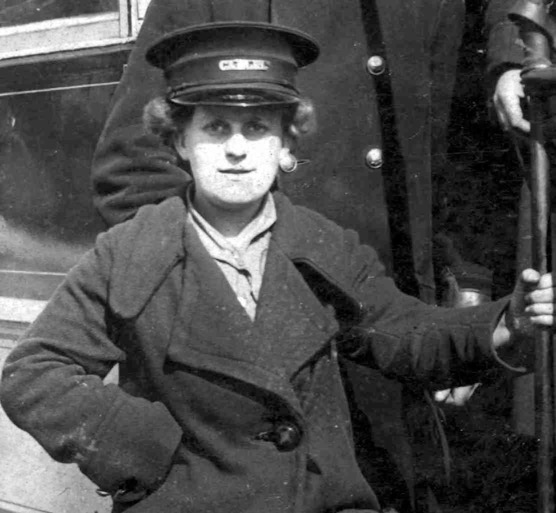
Another enlargement from the same photograph as the previous image, showing the other lady, probably also a conductress. Once again, whilst the cap would appear to be a standard male issue with cap badge, the coat is certainly informal.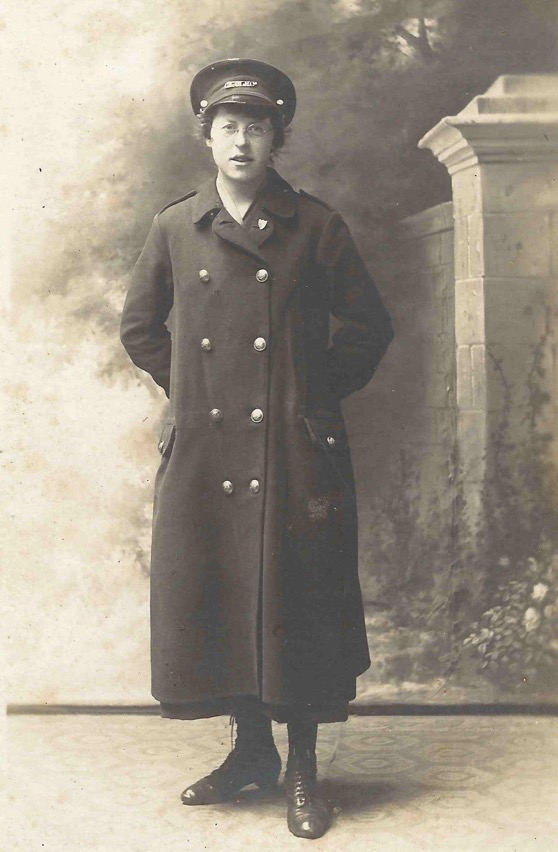
A studio portrait of a C&DLRCo Great War conductress. She is wearing a standard, male-issue cap and what would appear to be a standard male-issue greatcoat. Photo courtesy of the Richard Rosa Collection.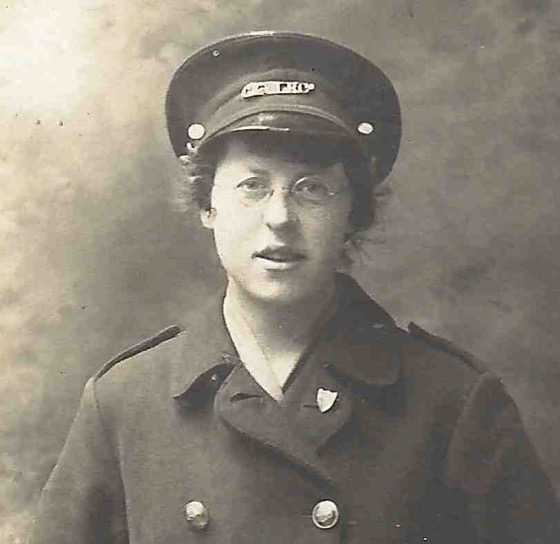
An enlargement of the above photograph showing details of the uniform. The purpose of the shield-shaped badge is unclear, though several of the ladies in the next photograph are also wearing it.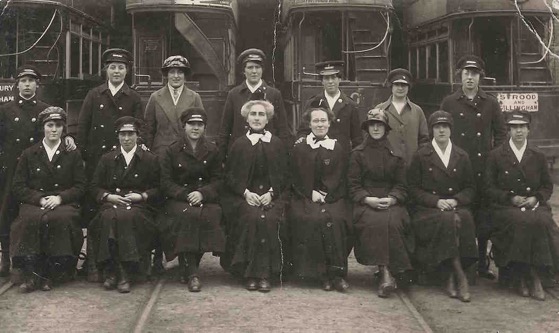
A group of C&DLR female employees lined up at the depot — photo undated, but presumably taken during the Great War. Apart from some of the baggy motor caps, the rest of the uniforms appear, to a greater or lesser extent, to be makeshift: male-issue greatcoats and caps, informal topcoats, informal hats and a variety of badges.The significance of the two vaguely religious-looking ladies at the centre of the front row is unknown, though it is possible that they were volunteer conductresses, as the tramway is known to have employed two curates as part-time drivers in 1917!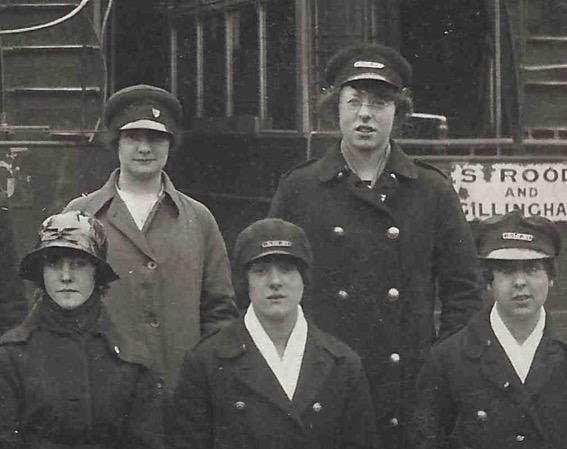
An enlargement of the above photograph showing five of the ladies in more detail. The lady on the back right is clearly the same lady depicted in the studio portrait above, though she would now seem to have a female-issue baggy motor cap rather than the standard male-issue cap. Three of the other ladies also appear to have company-issued motor caps, though only three have the standard cap badges. 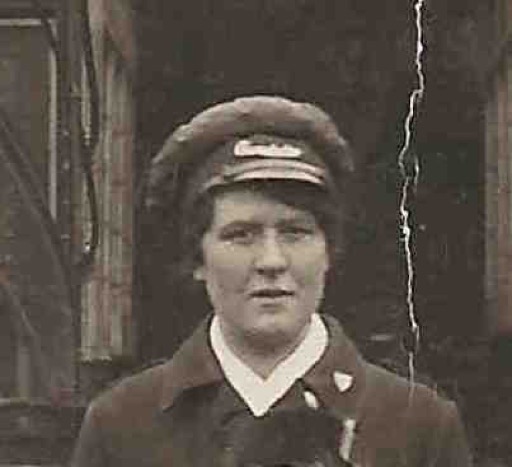
Another blow-up showing the lady standing at the centre back. Although she has a female-issue motor cap, it clearly has a script-lettering grade badge — 'Conductor' — rather than the normal company-initials badge. She is also wearing, as are several others of those present, an unidentified shield-shaped badge.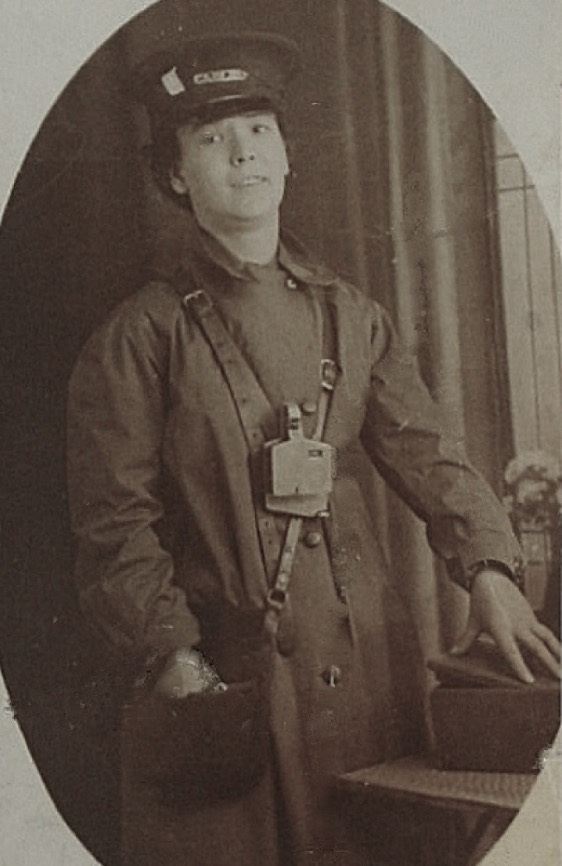
Another studio portrait of a C&DLRCo Great War tram conductress, this time in a gabardine-style raincoat, which was probably her own. With thanks to Mrs K Trice.